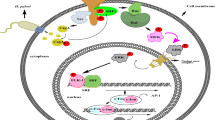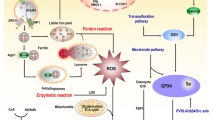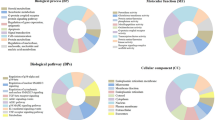Abstract
Purpose
Heat shock protein 90 (Hsp90), a potential therapeutic target, has been widely recognized in vitro and in vivo in immunodeficient mice. Here, we aimed to evaluate the role of Hsp90 in an immunocompetent mouse model of esophageal squamous cell cancer (ESCC).
Methods
The carcinogen 4-nitroquinoline 1-oxide (4NQO) was used to induce ESCC in C57BL/6 mice. Cancer progression was analyzed through observation of appearance, hematoxylin–eosin staining, immunohistochemical detection, and terminal dUTP nick-end labeling analysis.
Results
4NQO led to the progressive appearance of preneoplastic and tumoral lesions in the esophagus, with 100 % incidence of ESCC in situ occurring only after 16 weeks of carcinogen exposure. Most of these lesions evolved spontaneously into highly invasive ESCC even after 4NQO withdrawal (weeks 16–22). Interestingly, there was marked upregulation of Hsp90 and its client proteins in tumoral lesions at 22 weeks. Hsp90 inhibition by intraperitoneal injection of SNX-2112 over the following 2 weeks downregulated AKT and cyclin D1 expression, leading to significant reduction in tumor incidence and prevention of ESCC progression. Moreover, SNX-2112 treatment decreased proliferating cell nuclear antigen expression and increased the number of apoptotic cells in ESCC tissues.
Conclusions
Our in vivo findings support the contribution of Hsp90 to ESCC progression, which was achieved by stimulating apoptosis and inhibition of cell proliferation, and provide a strong rationale for further evaluation of Hsp90 inhibitors for treating ESCC.






Similar content being viewed by others
References
Akiyama H, Tsurumaru M, Kawamura T, Ono Y (1981) Principles of surgical treatment for carcinoma of the esophagus: analysis of lymph node involvement. Ann Surg 194(4):438–446
Bao XH, Takaoka M, Hao HF, Fukazawa T, Yamatsuji T, Sakurama K, Takigawa N, Nakajima M, Fujiwara T, Naomoto Y (2013) Antiproliferative effect of the HSP90 inhibitor NVP-AUY922 is determined by the expression of PTEN in esophageal cancer. Oncol Rep 29(1):45–50. doi:10.3892/or.2012.2074
Baselga J, Rischin D, Ranson M, Calvert H, Raymond E, Kieback DG, Kaye SB, Gianni L, Harris A, Bjork T, Averbuch SD, Feyereislova A, Swaisland H, Rojo F, Albanell J (2002) Phase I safety, pharmacokinetic, and pharmacodynamic trial of ZD1839, a selective oral epidermal growth factor receptor tyrosine kinase inhibitor, in patients with five selected solid tumor types. J Clin Oncol 20(21):4292–4302
Biamonte MA, Van de Water R, Arndt JW, Scannevin RH, Perret D, Lee WC (2010) Heat shock protein 90: inhibitors in clinical trials. J Med Chem 53(1):3–17. doi:10.1021/jm9004708
Chandarlapaty S, Sawai A, Ye Q, Scott A, Silinski M, Huang K, Fadden P, Partdrige J, Hall S, Steed P, Norton L, Rosen N, Solit DB (2008) SNX2112, a synthetic heat shock protein 90 inhibitor, has potent antitumor activity against HER kinase-dependent cancers. Clin Cancer Res 14(1):240–248. doi:10.1158/1078-0432.CCR-07-1667
Czerninski R, Amornphimoltham P, Patel V, Molinolo AA, Gutkind JS (2009) Targeting mammalian target of rapamycin by rapamycin prevents tumor progression in an oral-specific chemical carcinogenesis model. Cancer Prev Res (Phila) 2(1):27–36. doi:10.1158/1940-6207.CAPR-08-0147
Ekman S, Bergqvist M, Tell R, Bergstrom S, Lennartsson J (2010) Hsp90 as a therapeutic target in patients with oesophageal carcinoma. Expert Opin Ther Targets 14(3):317–328. doi:10.1517/14728221003621278
Faried A, Sohda M, Nakajima M, Miyazaki T, Kato H, Kuwano H (2004) Expression of heat-shock protein Hsp60 correlated with the apoptotic index and patient prognosis in human oesophageal squamous cell carcinoma. Eur J Cancer 40(18):2804–2811. doi:10.1016/j.ejca.2004.08.013
Fong LY, Lau KM, Huebner K, Magee PN (1997) Induction of esophageal tumors in zinc-deficient rats by single low doses of N-nitrosomethylbenzylamine (NMBA): analysis of cell proliferation, and mutations in H-ras and p53 genes. Carcinogenesis 18(8):1477–1484
Hong DS, Banerji U, Tavana B, George GC, Aaron J, Kurzrock R (2013) Targeting the molecular chaperone heat shock protein 90 (HSP90): lessons learned and future directions. Cancer Treat Rev 39(4):375–387. doi:10.1016/j.ctrv.2012.10.001
Huang KH, Veal JM, Fadden RP, Rice JW, Eaves J, Strachan JP, Barabasz AF, Foley BE, Barta TE, Ma W, Silinski MA, Hu M, Partridge JM, Scott A, DuBois LG, Freed T, Steed PM, Ommen AJ, Smith ED, Hughes PF, Woodward AR, Hanson GJ, McCall WS, Markworth CJ, Hinkley L, Jenks M, Geng L, Lewis M, Otto J, Pronk B, Verleysen K, Hall SE (2009) Discovery of novel 2-aminobenzamide inhibitors of heat shock protein 90 as potent, selective and orally active antitumor agents. J Med Chem 52(14):4288–4305. doi:10.1021/jm900230j
Jemal A, Bray F, Center MM, Ferlay J, Ward E, Forman D (2011) Global cancer statistics. CA Cancer J Clin 61(2):69–90. doi:10.3322/caac.20107
Jin L, Xiao CL, Lu CH, Xia M, Xing GW, Xiong S, Liu QY, Liu H, Li YC, Ge F, Wang QD, He QY, Wang YF (2009) Transcriptomic and proteomic approach to studying SNX-2112-induced K562 cells apoptosis and anti-leukemia activity in K562-NOD/SCID mice. FEBS Lett 583(12):1859–1866. doi:10.1016/j.febslet.2009.04.046
Ju HQ, Wang SX, Xiang YF, Liu Z, Liu JY, Chen ZP, Zeng FL, Xia M, Liu ZH, Xing GW, Wang SY, Wang YF (2011a) BJ-B11, a novel Hsp90 inhibitor, induces apoptosis in human chronic myeloid leukemia K562 cells through the mitochondria-dependent pathway. Eur J Pharmacol 666(1–3):26–34. doi:10.1016/j.ejphar.2011.05.020
Ju HQ, Xiang YF, Xin BJ, Pei Y, Lu JX, Wang QL, Xia M, Qian CW, Ren Z, Wang SY, Wang YF, Xing GW (2011b) Synthesis and in vitro anti-HSV-1 activity of a novel Hsp90 inhibitor BJ-B11. Bioorg Med Chem Lett 21(6):1675–1677. doi:10.1016/j.bmcl.2011.01.098
King MA, Scotty N, Klein RL, Meyer EM (2002) Particle detection, number estimation, and feature measurement in gene transfer studies: optical fractionator stereology integrated with digital image processing and analysis. Methods 28(2):293–299
Lam AK (2000) Molecular biology of esophageal squamous cell carcinoma. Crit Rev Oncol Hematol 33(2):71–90
Li H, Gao Q, Guo L, Lu SH (2011) The PTEN/PI3K/Akt pathway regulates stem-like cells in primary esophageal carcinoma cells. Cancer Biol Ther 11(11):950–958
Liu XL, Xiao B, Yu ZC, Guo JC, Zhao QC, Xu L, Shi YQ, Fan DM (1999) Down-regulation of Hsp90 could change cell cycle distribution and increase drug sensitivity of tumor cells. WJG 5(3):199–208
Liu KS, Ding WC, Wang SX, Liu Z, Xing GW, Wang Y, Wang YF (2012a) The heat shock protein 90 inhibitor SNX-2112 inhibits B16 melanoma cell growth in vitro and in vivo. Oncol Rep 27(6):1904–1910. doi:10.3892/or.2012.1738
Liu KS, Liu H, Qi JH, Liu QY, Liu Z, Xia M, Xing GW, Wang SX, Wang YF (2012b) SNX-2112, an Hsp90 inhibitor, induces apoptosis and autophagy via degradation of Hsp90 client proteins in human melanoma A-375 cells. Cancer Lett 318(2):180–188. doi:10.1016/j.canlet.2011.12.015
Liu KS, Zhang Y, Ding WC, Wang SX, Xiang YF, Yang P, Chen ZP, Zheng K, Liu Z, Xia M, Wang YF (2012c) The selective Hsp90 inhibitor BJ-B11 exhibits potent antitumor activity via induction of cell cycle arrest, apoptosis and autophagy in Eca-109 human esophageal squamous carcinoma cells. Int J Oncol 41(6):2276–2284. doi:10.3892/ijo.2012.1670
Miyamoto S, Yasui Y, Kim M, Sugie S, Murakami A, Ishigamori-Suzuki R, Tanaka T (2008) A novel rasH2 mouse carcinogenesis model that is highly susceptible to 4-NQO-induced tongue and esophageal carcinogenesis is useful for preclinical chemoprevention studies. Carcinogenesis 29(2):418–426. doi:10.1093/carcin/bgm225
Motoori M, Takemasa I, Yamasaki M, Komori T, Takeno A, Miyata H, Takiguchi S, Fujiwara Y, Yasuda T, Yano M, Matsuura N, Matsubara K, Monden M, Mori M, Doki Y (2010) Prediction of the response to chemotherapy in advanced esophageal cancer by gene expression profiling of biopsy samples. Int J Oncol 37(5):1113–1120
Nagasawa S, Onda M, Sasajima K, Makino H, Yamashita K, Takubo K, Miyashita M (2001) Cyclin D1 overexpression as a prognostic factor in patients with esophageal carcinoma. J Surg Oncol 78(3):208–214
Nilsson B, Bumming P, Meis-Kindblom JM, Oden A, Dortok A, Gustavsson B, Sablinska K, Kindblom LG (2005) Gastrointestinal stromal tumors: the incidence, prevalence, clinical course, and prognostication in the preimatinib mesylate era—a population-based study in western Sweden. Cancer 103(4):821–829. doi:10.1002/cncr.20862
Ohkawa T, Naomoto Y, Takaoka M, Nobuhisa T, Noma K, Motoki T, Murata T, Uetsuka H, Kobayashi M, Shirakawa Y, Yamatsuji T, Matsubara N, Matsuoka J, Haisa M, Gunduz M, Tsujigiwa H, Nagatsuka H, Hosokawa M, Nakajima M, Tanaka N (2004) Localization of heparanase in esophageal cancer cells: respective roles in prognosis and differentiation. Lab Investig 84(10):1289–1304. doi:10.1038/labinvest.3700159
Okawa Y, Hideshima T, Steed P, Vallet S, Hall S, Huang K, Rice J, Barabasz A, Foley B, Ikeda H, Raje N, Kiziltepe T, Yasui H, Enatsu S, Anderson KC (2009) SNX-2112, a selective Hsp90 inhibitor, potently inhibits tumor cell growth, angiogenesis, and osteoclastogenesis in multiple myeloma and other hematologic tumors by abrogating signaling via Akt and ERK. Blood 113(4):846–855. doi:10.1182/blood-2008-04-151928
Oyama K, Okawa T, Nakagawa H, Takaoka M, Andl CD, Kim SH, Klein-Szanto A, Diehl JA, Herlyn M, El-Deiry W, Rustgi AK (2007) AKT induces senescence in primary esophageal epithelial cells but is permissive for differentiation as revealed in organotypic culture. Oncogene 26(16):2353–2364. doi:10.1038/sj.onc.1210025
Pestell RG (2013) New roles of cyclin D1. Am J Pathol 183(1):3–9. doi:10.1016/j.ajpath.2013.03.001
Qi YJ, Chao WX, Chiu JF (2012) An overview of esophageal squamous cell carcinoma proteomics. J Proteomics 75(11):3129–3137. doi:10.1016/j.jprot.2012.04.025
Takahashi K, Miyashita M, Makino H, Akagi I, Orita H, Hagiwara N, Nomura T, Gabrielson EW, Tajiri T (2009) Expression of Akt and Mdm2 in human esophageal squamous cell carcinoma. Exp Mol Pathol 87(1):42–47. doi:10.1016/j.yexmp.2008.11.013
Tang XH, Knudsen B, Bemis D, Tickoo S, Gudas LJ (2004) Oral cavity and esophageal carcinogenesis modeled in carcinogen-treated mice. Clin Cancer Res 10(1 Pt 1):301–313
To KK, Yu L, Liu S, Fu J, Cho CH (2012) Constitutive AhR activation leads to concomitant ABCG2-mediated multidrug resistance in cisplatin-resistant esophageal carcinoma cells. Mol Carcinog 51(6):449–464. doi:10.1002/mc.20810
Wang SX, Ju HQ, Liu KS, Zhang JX, Wang X, Xiang YF, Wang R, Liu JY, Liu QY, Xia M, Xing GW, Liu Z, Wang YF (2011) SNX-2112, a novel Hsp90 inhibitor, induces G2/M cell cycle arrest and apoptosis in MCF-7 cells. Biosci Biotechnol Biochem 75(8):1540–1545
Wang R, Shao F, Liu Z, Zhang J, Wang S, Liu J, Liu H, Chen H, Liu K, Xia M, Wang Y (2013) The Hsp90 inhibitor SNX-2112, induces apoptosis in multidrug resistant K562/ADR cells through suppression of Akt/NF-kappaB and disruption of mitochondria-dependent pathways. Chem Biol Interact 205(1):1–10. doi:10.1016/j.cbi.2013.06.007
Wilkey JF, Buchberger G, Saucier K, Patel SM, Eisenberg E, Nakagawa H, Michaylira CZ, Rustgi AK, Mallya SM (2009) Cyclin D1 overexpression increases susceptibility to 4-nitroquinoline-1-oxide-induced dysplasia and neoplasia in murine squamous oral epithelium. Mol Carcinog 48(9):853–861. doi:10.1002/mc.20531
Wu X, Wanders A, Wardega P, Tinge B, Gedda L, Bergstrom S, Sooman L, Gullbo J, Bergqvist M, Hesselius P, Lennartsson J, Ekman S (2009) Hsp90 is expressed and represents a therapeutic target in human oesophageal cancer using the inhibitor 17-allylamino-17-demethoxygeldanamycin. Br J Cancer 100(2):334–343. doi:10.1038/sj.bjc.6604855
Zhai QQ, Gong GQ, Luo Y, Wang QD, Xia M, Xing GW, Li YC, Jiang JH, Liu Z, Liu QY, Wang YF (2010) Determination of SNX-2112, a selective Hsp90 inhibitor, in plasma samples by high-performance liquid chromatography and its application to pharmacokinetics in rats. J Pharm Biomed Anal 53(4):1048–1052. doi:10.1016/j.jpba.2010.06.031
Acknowledgments
This work was supported by grants from the National Natural Science Foundation of China (Grant 81201727), the National High Technology Research and Development Program of China (2012aA02A503), the open project of State Key Laboratory of Molecular Oncology (SKL-KF-2013-14), the Major Platform Project Funds of Administration of Ocean and Fisheries of Guangdong, China (GD2012-D01-002), the Science and Technology Program of Guangzhou, China (2011Y1-00022), the China Postdoctoral Science Foundation (Grants 2012M511882, 2013T60827), the Science and Technology Innovation Key Project of Guangdong Higher Education Institutes (CXZD1110), Science and Technology Program of Guangzhou (2014J4100103), and the Natural Science Foundation of Guangdong Province (Grant S2012040006873).
Conflict of interest
The authors declare no conflict of interest.
Author information
Authors and Affiliations
Corresponding authors
Additional information
Shaoxiang Wang and Zhan Du have contributed equally to this study.
Rights and permissions
About this article
Cite this article
Wang, S., Du, Z., Luo, J. et al. Inhibition of heat shock protein 90 suppresses squamous carcinogenic progression in a mouse model of esophageal cancer. J Cancer Res Clin Oncol 141, 1405–1416 (2015). https://doi.org/10.1007/s00432-014-1896-8
Received:
Accepted:
Published:
Issue Date:
DOI: https://doi.org/10.1007/s00432-014-1896-8




